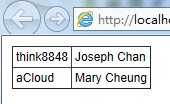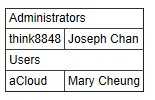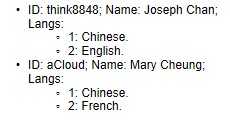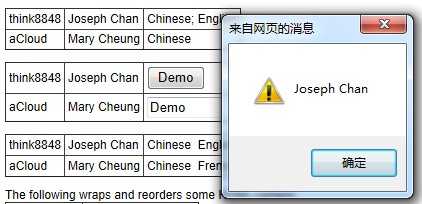标签:
官方解释对该插件的说明:将匹配的第一个元素作为模板,render指定的数据,签名如下:
.tmpl([data,][options])
其中参数data的用途很明显:用于render的数据,可以是任意js类型,包括数组和对象。options一般情况下都是选项了,官方指出,此处的options是一个用户自定义的键值对的map,继承自tmplItem数据结构,适用于模板render动作期间。
好吧,先来一个最直观的例子:
<%@ Page Language="C#" AutoEventWireup="true" %>
<!DOCTYPE html>
<html>
<head>
<title>jquery template demo</title>
<link rel="stylesheet" href="content/site.css" type="text/css" />
<link rel="stylesheet" href="content/jquery.ui.css" type="text/css" />
<script type="text/javascript" src="scripts/jquery.js"></script>
<script type="text/javascript" src="scripts/jquery.ui.js"></script>
<script type="text/javascript" src="scripts/jquery.tmpl.js"></script>
<script id="myTemplate" type="text/x-jquery-tmpl">
<tr><td>${ID}</td><td>${Name}</td></tr>
</script>
<script type="text/javascript">
$(function () {
var users = [{ ID: ‘think8848‘, Name: ‘Joseph Chan‘ }, { ID: ‘aCloud‘, Name: ‘Mary Cheung‘}];
$(‘#myTemplate‘).tmpl(users).appendTo(‘#rows‘);
});
</script>
<style type="text/css">
body
{
padding: 10px;
}
table
{
border-collapse: collapse;
}
</style>
</head>
<body>
<table cellspacing="0" cellpadding="3" border="1">
<tbody id="rows">
</tbody>
</table>
</body>
</html>

例子虽然很小也很简单,但我觉得这个已经很有用了。
当然,.tmpl()还可以使用来自远端的数据,比如说服务:
public ActionResult SampleData()
{
var json = new JsonResult();
json.Data = new[] { new { ID = "remote1", Name = "abcd" }, new { ID = "remote2", Name = "efg" } };
json.JsonRequestBehavior = JsonRequestBehavior.AllowGet;
return json;
}
这是一个MVC的Action,我把它当做是一个提供数据的服务,然后js代码如下:
$(‘#btnAjax‘).click(function () {
$.getJSON(‘@Url.Action("SampleData", "Home")‘, function (json) {
$(‘#rows‘).empty();
$(‘#myTemplate‘).tmpl(json).appendTo(‘#rows‘);
});
});
效果:

定义模板时,推荐的方式为定义使用
<script id=‘templateName‘ type=‘text/x-jquery-tmpl‘></script>
做为模板的包装器,但定义方式并不只有这一种,你可以使用
<div id="template" style="display: none;"> <!-- markup --></div>
的方式来定义,但是官方文档中说,这种方法可能会产生浏览器无法解析的HTML,因此不推荐使用,不过我试了下,倒没有出什么意外:
HTML:
<div id="container">
</div>
<div id="inline" style="display: none">
<label>
${ID}</label>
<label>
${Name}</label><br />
</div>
Javascript:
var users = [{ ID: ‘think8848‘, Name: ‘Joseph Chan‘ }, { ID: ‘aCloud‘, Name: ‘Mary Cheung‘}];
$(‘#inline‘).tmpl(users).appendTo(‘#container‘);
效果:

编译缓存模板,在jQuery .tmpl()中,还可以将模板事先编译并缓存起来,然后在合适的时侯再使用,这对于一些数据嵌套是很有用的,如:
Html
<table cellspacing="0" cellpadding="3" border="1">
<tbody id="compileRows">
</tbody>
</table>
Javascript
<script id="compile1" type="text/x-jquery-tmpl">
{{tmpl ‘cached‘}}
<tr><td>${ID}</td><td>${Name}</td></tr>
</script>
<script id="compile2" type="type/x-jquery-tmpl">
<tr><td colspan="2">${Group}</td></tr>
</script>
<script type="text/javascript">
$(function () {
var groupUsers = [{ ID: ‘think8848‘, Name: ‘Joseph Chan‘, Group: ‘Administrators‘ }, { ID: ‘aCloud‘, Name: ‘Mary Cheung‘, Group: ‘Users‘}];
$(‘#compile2‘).template(‘cached‘);
$(‘#compile1‘).tmpl(groupUsers).appendTo(‘#compileRows‘);
});
</script>
效果:

$.template()方法,将一段Html编译为模板,示例:
Javascript
var markup = ‘<tr><td>${ID}</td><td>${Name}</td></tr>‘;
$.template(‘template‘, markup);
$.tmpl(‘template‘, users).appendTo(‘#templateRows‘);
这样就可以将markup中定义的模板应用于templateRows对象。
jQuery .tmpl()的标签,表达式,属性:
${}:从前面的例子来看,这个标签的作用很明显了,相当于是占位符,但是它还有另一种写法{{= field}}如:
<script id="myTemplate" type="text/x-jquery-tmpl">
<tr><td>{{= ID}}</td><td>{{= Name}}</td></tr>
</script>
必须要注意的是,"="号后必须跟一个空格,不然是没有效果的。
另外,${}中还可以放表达式,这个牛x吧,如:
Html
<table cellspacing="0" cellpadding="3" border="1">
<tbody id="expressionRows">
</tbody>
</table>
Javascript
<script type="text/javascript">
$(function () {
var userLangs = [{ ID: ‘think8848‘, Name: ‘Joseph Chan‘, Langs: [‘Chinese‘, ‘English‘] }, { ID: ‘aCloud‘, Name: ‘Mary Cheung‘, Langs: [‘Chinese‘, ‘French‘]}];
$(‘#expression‘).tmpl(userLangs).appendTo(‘#expressionRows‘);
});
</script>
效果:

jQuery .tmpl()有两个比较有用的属性:$item、$data:
$item代表当前的模板;$data代表当前的数据。
Html
<table cellspacing="0" cellpadding="3" border="1">
<tbody id="propertyRows">
</tbody>
</table>
Javascript
<script id="property" type="text/x-jquery-tmpl">
<tr><td>${ID}</td><td>${$data.Name}</td><td>${$item.getLangs(‘; ‘)}</td></tr> </script>
<script type="text/javascript">
$(function () {
var userLangs = [{ ID: ‘think8848‘, Name: ‘Joseph Chan‘, Langs: [‘Chinese‘, ‘English‘] }, { ID: ‘aCloud‘, Name: ‘Mary Cheung‘, Langs: [‘Chinese‘, ‘French‘]}];
$(‘#property‘).tmpl(userLangs, {
getLangs: function (separator) {
return this.data.Langs.join(separator);
}
})
.appendTo(‘#propertyRows‘);
});
</script>
效果:

{{each}}这个标签一看就知道是做循环用的了,用法如下:
Html
<ul id="eachList">
</ul>
Javascript
<script id="each" type="text/x-jquery-tmpl">
<li>ID: ${ID}; Name: ${Name};<br />Langs:<ul>{{each Langs}}<li>${$index + 1}: <label>${$value}. </label></li>{{/each}}<ul></li>
</script>
<script type="text/javascript">
$(function () {
var userLangs = [{ ID: ‘think8848‘, Name: ‘Joseph Chan‘, Langs: [‘Chinese‘, ‘English‘] }, { ID: ‘aCloud‘, Name: ‘Mary Cheung‘, Langs: [‘Chinese‘, ‘French‘]}];
$(‘#each‘).tmpl(userLangs).appendTo(‘#eachList‘);
});
效果:

{{each}}还有另一种写法:
Javascript
<script id="each2" type="text/x-jquery-tmpl">
<li>ID: ${ID}; Name: ${Name};<br />Langs:<ul>{{each(i,lang) Langs}}<li>${i + 1}: <label>${lang}. </label></li>{{/each}}</ul></li>
</script>
作用和前一种是一样的。
{{if}}和{{else}},这两个标签应该一看就知道作用了,直接上示例:
Javascript
<script id="ifelse" type="text/x-jquery-tmpl">
<tr><td>${ID}</td><td>${Name}</td><td>{{if Langs.length > 1}}${Langs.join(‘; ‘)}{{else}}${Langs}{{/if}}</td></tr>
</script>
如果Langs数组元素超过1个,则用‘; ‘连接起来,否则就直接显示Langs,效果:

{{html}},直接将对象属性值作为HTML代码替换占位符:
Javascript
<script id="html" type="text/x-jquery-tmpl">
<tr><td>${ID}</td><td>${Name}</td><td>{{html Ctrl}}</td></tr>
</script>
<script type="text/javascript">
$(function () {
var ctrls = [{ ID: ‘think8848‘, Name: ‘Joseph Chan‘, Ctrl: ‘<input type="button" value="Demo" />‘ }, { ID: ‘aCloud‘, Name: ‘Mary Cheung‘, Ctrl: ‘<input type="text" value="Demo" />‘}];
$(‘#html‘).tmpl(ctrls).appendTo(‘#htmlRows‘);
});
</script>
效果:

{{tmpl}},前面已经提过该标签了,这里再给一个使用参数的例子:
Javascript
<script id="tmpl1" type="text/x-jquery-tmpl">
<tr><td>${ID}</td><td>${Name}</td><td> {{tmpl($data) ‘#tmpl2‘}}</td></tr>
</script>
<script id="tmpl2" type="type/x-jquery-tmpl">
{{each Langs}}${$value} {{/each}}
</script>
<script type="text/javascript">
$(function () {
var userLangs = [{ ID: ‘think8848‘, Name: ‘Joseph Chan‘, Langs: [‘Chinese‘, ‘English‘] }, { ID: ‘aCloud‘, Name: ‘Mary Cheung‘, Langs: [‘Chinese‘, ‘French‘]}];
$(‘#tmpl1‘).tmpl(userLangs).appendTo(‘#tmplRows‘);
});
</script>
效果:

{{wrap}},包装器,这回不需要指定对哪一个元素使用模板了,直接生成模板的包装器,示例:
Html
<div id="wrapDemo">
</div>
Javascript
<script id="myTmpl" type="text/x-jquery-tmpl">
The following wraps and reorders some HTML content:
{{wrap "#tableWrapper"}}
<h3>One</h3>
<div>
First <b>content</b>
</div>
<h3>Two</h3>
<div>
And <em>more</em> <b>content</b>...
</div>
{{/wrap}}
</script>
<script id="tableWrapper" type="text/x-jquery-tmpl">
<table cellspacing="0" cellpadding="3" border="1"><tbody>
<tr>
{{each $item.html("h3", true)}}
<td>
${$value}
</td>
{{/each}}
</tr>
<tr>
{{each $item.html("div")}}
<td>
{{html $value}}
</td>
{{/each}}
</tr>
</tbody></table>
</script>
<script type="text/javascript">
$(function () {
$(‘#myTmpl‘).tmpl().appendTo(‘#wrapDemo‘);
});
</script>
效果:

$.tmplItem()方法,使用这个方法,可以获取从render出来的元素上重新获取$item,示例:
$(‘tbody‘).delegate(‘tr‘, ‘click‘, function () {
var item = $.tmplItem(this);
alert(item.data.Name);
});
效果:

标签:
原文地址:http://www.cnblogs.com/qixuejia/p/5188505.html